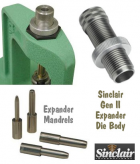All my brass is either Norma, Lapua or GECO.Canuckenstein, Yes you can certainly get where you want to go without gages or inspection equipment. It really comes down to each of us to decide on how much we invest in tools that may or may not get used for general purposes at home, so I don’t blame you for not wanting to get gage pins if they will collect dust. (See if any of your friends already have a set they can loan you?)
After the responses, I think you can get the main points about FL die dimensions.
Most FL size dies overwork brass and may induce runout when the expander ball comes back through. The hybrid solution where the die diameter is honed and minimized usually produces the longest case life and lowest runout. There are also benefits from exploring the alternative methods for expansion using mandrels or ball sets that come in fine increments.
You would probably be better off with a bushing die if you don’t mind the investment. Neck turning also starts with brass at the correct diameter for a pilot mandrel in order to produce good results, so even there you would need to control the sizing. This is another argument for sizing controls with mandrels.
Neck turning brass may help brass runout in instances where the brass is of low quality to begin with. The relationship of the FL die dimensions and the chamber of sporter rifles can sometimes set up situations where this combination further works the brass over the long term, but only testing can answer if turning is any benefit in a sporter context. My guess is that outcome would be based on your brass and how many different batches and brands of brass you are running.
Many of us have been at this game for a lifetime and since a young age. As a result, we have many overlapping tools and methods to manage brass and neck tension. We often have to use our imagination to picture starting out late in life or from a standing start without the benefit of all the collected tools and mentoring.
My last guess is you will end up with all three capabilities on your bench, honed FL dies with more than one expander, a bushing die with a span of bushings, as well as neck turning equipment to satisfy your curiosity. But I will also guess you have more to gain from the first two and buying better brass so you can skip neck turning.
I just posted another reply about the headaches from RCBS dies. However my RCBS dies for 8mm Mauser are spot on. But out of the 4 sets I own 3 consistently give excess run out. That’s a 75% Failure rate in my eyes. I have even tried the offending dies in the presses of my friends. One was a COAX the other was a Lee Classic cast and a Redding big boss. All gave excess run out. Not to come across as a douche but I’ve also been involved with guns since I was small. However I inherited nothing from my step grandfather except knowledge and the ability to shoot better than most.
All his dies were L E Wilson or Redding.
Any how I gotta tend to some .308 that’s calling name.
Regards
Jon














